The invention of the electric motor 1800-1854
Univ.-Prof. Dr.-Ing. Martin Doppelbauer
Summary
With the invention of the battery (Allessandro Volta, 1800), the generation of a magnetic field from electric current (Hans Christian Oersted, 1820) and the electromagnet (William Sturgeon, 1825) the foundation for building electric motors was laid. At that time it was still open whether electric motors should be rotating or reciprocating machines, i.e. simulate a plunger rod of a steam engine.
Worldwide, many inventors worked in parallel on this task - it was a "fashion" problem. New phenomena were discovered almost daily. Inventions in the field of electrical science and its applications were in the air.
Often the inventors knew nothing about each other and developed similar solutions independently. National histories are shaped accordingly until present day. The following is an attempt to provide a comprehensive and neutral picture.
The first rotating device driven by electromagnetism was built by the Englishman Peter Barlow in 1822 (Barlow's Wheel).
After many other more or less successful attempts with relatively weak rotating and reciprocating apparatus the German-speaking Prussian Moritz Jacobi created the first real rotating electric motor in May 1834 that actually developed a remarkable mechanical output power. His motor set a world record which was improved only four years later in September 1838 by Jacobi himself. His second motor was powerful enough to drive a boat with 14 people across a wide river. It was not until 1839/40 that other developers worldwide managed to build motors of similar and later also of higher performance.
Already in 1833 the German Heinrich Friedrich Emil Lenz published an article about the law of reciprocity of the magneto-electric and electromagnetic phenomena, i.e. the reversibility of electric generator and motor. In 1838 he provided a detailed description of his experiments with a Pixii-generator that he operated as a motor.
In 1835 the two Dutchmen Sibrandus Stratingh and Christopher Becker built an electric motor that powered a small model car. This is the first known practical application of an electric motor. In February 1837 the first patent for an electric motor was granted to the US-american Thomas Davenport.
However, all the early developments by Jacobi, Stratingh, Davenport and others eventually did not lead to the electric motors we know today.
The DC motor was not created from these engines, but rather from the development of power generators (dynamometers). The foundations were laid by William Ritchie and Hippolyte Pixii in 1832 with the invention of the commutator and, most importantly, by Werner Siemens in 1856 with the Double-T-anchor and by his chief engineer, Friedrich Hefner-Alteneck, in 1872 with the drum armature. DC motors still have a dominant market position today in the low power (below 1 kW) and low voltage (below 60 V) range.
The years 1885 until 1889 saw the invention of the three-phase electric power system which is the basis for modern electrical power transmission and advanced electric motors. A single inventor for the three-phase power system can not be named. There are several more or less well known names who were all deeply involved in the inventions (Bradley, Dolivo-Dobrowolsky, Ferraris, Haselwander, Tesla and Wenström).Timetable 1800 - 1834: First experiments with electromagnetical devices
| 1800 | For the first time Allessandro Volta (Italian) produces a continuous electrical power (as opposed to a spark or static electricity) from a stack of silver and zinc plates. |
| 1820 |
Hans Christian Oersted (Denish) finds the generation of a magnetic field by electric currents by observation of the deflection of a compass needle. This was the first time a mechanical movement was caused by an electric current.
|
| 1820 | André-Marie Ampère (French) invents the cylindric coil (solenoid). |
| 1821 | Michael Faraday (British) creates two experiments for the demonstration of electromagnetic rotation. A vertically suspended wire moves in a circular orbit around a magnet. | 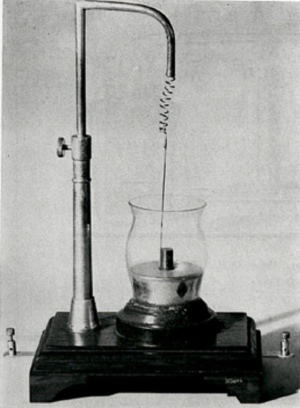 Rotating wire by Faraday, 1821 Photo courtesy of Division of Work & Industry, National Museum of American History, Smithsonian Institution |
| 1822 | Peter Barlow (British) invents a spinning wheel (Barlow's wheel = unipolar machine). | 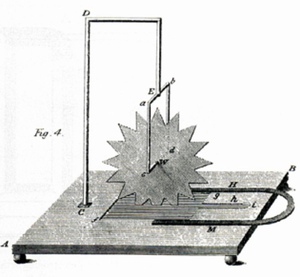 Barlow's wheel, 1822 Philosophical Magazine, 1822, vol. 59 |
| 1825- 1826 | William Sturgeon (British) invents the electromagnet, a coil of wires with an iron core to enhance the magnetic field. |
 First electromagnet by Sturgeon, 1825 Transactions of the Society for the Encouragement of the Arts, Manufacturers and Commerce, 1824, vol. 43, pl. 3 |
| 1827-1828 | Istvan (Ányos) Jedlik (Hungarian) invents the first rotary machine with electromagnets and a commutator. However, Jedlik publicly reported his invention only decades later and the actual invention date is uncertain. Still many Hungarians believe Jedlik has invented the electric motors. A functional model of his apparatus is displayed at the art museum in Budapest. Although this could actually be the first electric motor it has to be realized that this device had no influence on further development of electric machines. Jedlik's invention remained hidden for a long time and was not pursued by the inventor. The field of electrical engineering owes Jedlik nothing. |
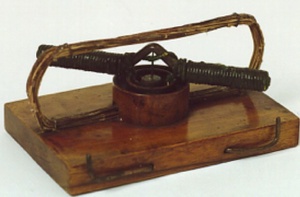 Rotary device by Jedlik, 1827/28 Photo: Wikipedia 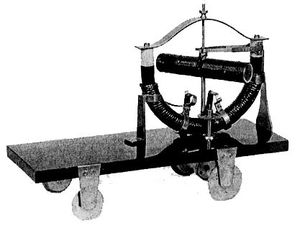 Jedlik's electric car, 1827/28 Photo: Wikipedia |
| before 1830 |
Johann Michael Ekling, mechanic in Vienna, builds a motor according to the plans and ideas of Prof. Andreas von Baumgartner (Austrian physicist; since 1823 Professor of Physics and Applied Mathematics in Vienna). This apparatus was aquired in 1830 by the University of Innsbruck for the price of 50 fl c.m. The year of construction is unknown, but must have been before 1830 as the date of purchase is proven.
|
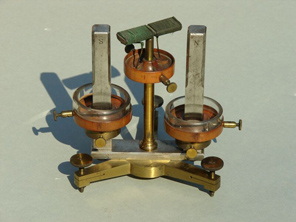 Baumgartner's Engine, built by Ekling, before 1830 Photo courtesy of the University of Innsbruck, Museum of Experimental Physics, Ao. Univ. Prof. Mag. Dr. Armin Denoth. |
| 1831 | Michael Faraday (British) discovers and investigates electromagnetic induction, i.e. the generation of an electric current due to a varying magnetic field (the reversal of Oersted's discovery). Faraday lays the foundation for the development of the electric generator. |
| 1831 | Joseph Henry (US-American) finds the induction law independent of Faraday and builds a small magnetic rocker. He describes it as a "philosophical toy". In an article for the english Philosophical Magazine, in 1838 Englishman F. Watkins acknowledges Henry's device in detail and calls it the first electric motor ever known. This view extends to present day mainly in British literature. |
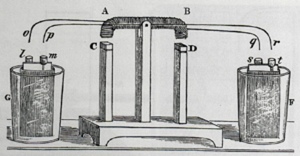 Henry's magnetic rocker, 1831 American Journal of Science, 1831, vol. 20, p. 342 |
| April 1832 |
Savatore dal Negro (Italian) builds a device that can lift 60 grams in one second by 5 centimeters and hence develops nearly 30 mW mechanical power. He was probably inspired by Henry's magnetic rocker and creates a similar reciprocating machine. However, Dal Negro's device can produce motion by a special gear arrangement. Dal Negro describes his experiments in a letter of April 1832 and later in a scientific paper „Nuova Macchina élettro-magnetica“ in March 1834. His devices are stored at the Museum of the History of Physics at the University of Padua. Unfortunately, they are not displayed. |
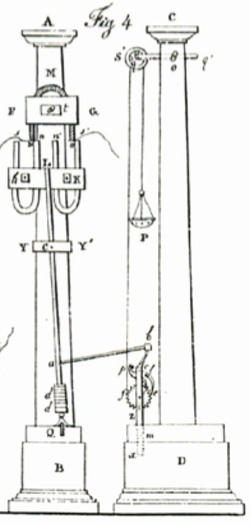 Dal Negro's electromagnetic pendulum, 1832 Annali delle Scienze de Regno Lombardo-Veneto, März 1834, pl. 4 |
| July 1832 |
First public description of a rotating electric machine. The author is an anonymous letter-writer with the initials P.M. He has now been identified with high probability as the Irishman Frederick Mc-Clintock from Dublin. Michael Faraday, the recipient of the letter on 26 July 1832. publishes it immediately. For the first time a rotating electric machine is described in public. |
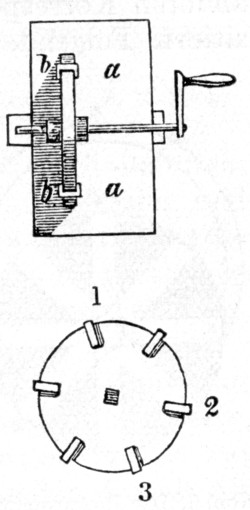 First description of a rotating electrical machine by P.M., 1832 Philosophical Magazine, 1832, p. 161-162 |
| July 1832 |
Hippolyte Pixii (French) builds the first apparatus for generating an alternating current out of a rotation .
The device is presented publicly in September 1832 at a meeting of the Académie des Sciences. His description is printed already in the July issue of the Annales de Chimie. Pixii improved his device in the same year by adding a switching device. He can now produce a pulsating direct current. |
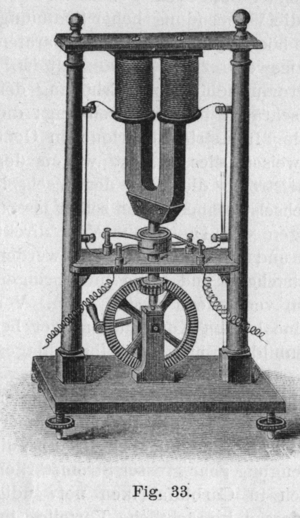 Pixii's first DC generator, 1832/33 F. Niethammer, Ein- und Mehrphasen-Wechsel-strom-Erzeuger, Verlag S. Hirzel, Leipzig 1906 |
| 1832 | William Ritchie (British) reported in March 1833 of a device that he claimed to have built already nine month earlier in the summer of 1832. It is a rotating electromagnetic generator with four rotor coils, a commutator and brushes.
Ritchie is therefore generally regarded as the inventor of the commutator. At the end of his article Ritchie describes how he was able to rotate an electric magnet by utilization of the magnetic field of the earth. He could raise a weight of several ounces (50-100 grams). The commutation was performed by two wire ends, which ran into two semicircular troughs of mercury.
|
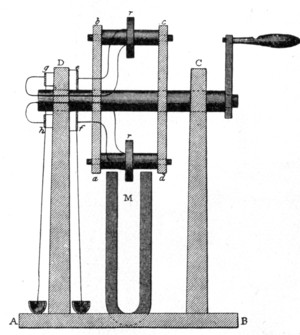 First DC generator with commutator, 1832/33 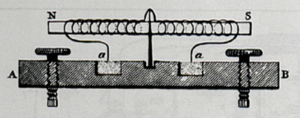 Ritchie's revolving coil, 1833 Philosophical Trans. of the Royal Society of London, 1833, Vol. 132, p.316, pl.7 |
| Jan 1833 |
A Dr. Schulthess gives a lecture at the Society of Engineers in Zurich in 1832, in which he describes his ideas of an electric motor. In January of 1833 he successfully demonstrated a machine before the same Zurich society. No further details are known. |
|
| March 1833 |
In the autumn of 1832 William Sturgeon builds a rotating electric device that he publicly displays in March 1833 in London. As with Jedlik there are is no definite evidence of the date and details of his construction. Sturgeon reported in 1836 in the first edition of his own magazine about the invention. |
 Rotation device of Sturgeon, 1832 Sturgeon's Annals of Electricity, 1836/37, vol. 1 |
| Dec. 1833 |
In the early years of electrical engineering it was strictly distinguished between the magnetic-electro machines, i.e. electric generators, and electro-magnetic machines, i.e. electric motors.
Heinrich Friedrich Emil Lenz (German) found the "law of reciprocity of the magneto-electric and electromagnetic phenomena", i.e. the reversibility of electric generator and motor. His scientific text is recited at the end of 1833 at the St. Petersburg Academy of Sciences and published in 1834 in Poggendorff's Annalen der Physik und Chemie. His ideas are slowly becoming commonplace, especially in 1838 after several reports of successful reversal experiments.
Sometimes it is claimed that the reversal principle was discovered in 1861 by the Italian Pacinotti or even only in 1873 by chance at the Vienna World Exhibition. Both claims are false. Emil Lenz widely reported already in 1838 in Poggendorff's Annalen der Physik und Chemie how he used a Pixii generator as a motor.
|
| July 1834 |
Guiseppe Domenico Botto (Italian), a physics professor in Turin, publishes in July 1834 in the Geneva magazine Bibliotheque Universelle the description of an electric motor, on which he works.
His device corresponds to a metronome (similar to Henry's and Dal Negro's constructions), acting on the pendulum with two electromagnets. Rotary motion is generated via a piston rod. A replica of the device is now on display in the Museo Galileo in Florence. |
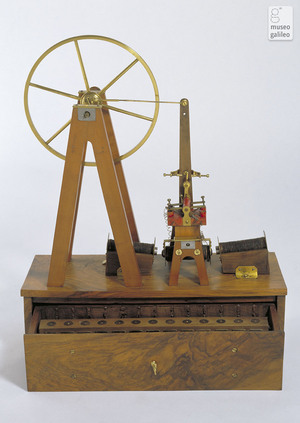 Rotary machine of Botto, July 1834 (Reconstruction) Photo courtesy of Museo Galileo, Florence |
Timetable 1834 - 1837: The first real electric motors
| May 1834 |
Moritz Hermann Jacobi (German-speaking Prussian, naturalized Russian) starts with experiments on a horseshoe-shaped electromagnet in early 1833 in Königsberg (then Prussia, now Russia). In January 1834 he writes in a letter to Poggendorff, editor of the Annalen der Physik und Chemie of his successes. He turns to the construction of an electric motor, which he completes in May 1834. His motor lifts a weight of 10 to 12 pounds with a speed of one foot per second, which is equivalent to about 15 watts of mechanical power. Jacobi expressly claimed in the memorandum of 1835 that he was not the sole inventor of the electromagnetic motor. He indicates the priority of the inventions of Botto and Dal Negro. However, Jacobi is undoubtedly the first to create a usable rotating electric motor. A fully functional replica of his engine is displayed at the Institute of Electric Engineering (ETI) of the Karlsruhe Institute of Technology (KIT) in the Engelbert-Arnold-Strasse 5 (Building 11.10) in Karlsruhe, Germany. |
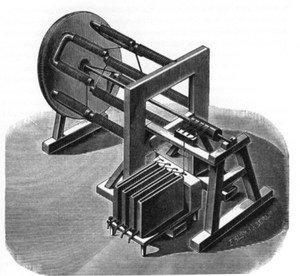 The first real electric motor Moritz Jacobi, Königsberg, May 1834 |
| Oct. 1834 |
The US-American T. Edmundson builds an electromagnetic rotary device that resembles a water wheel. | 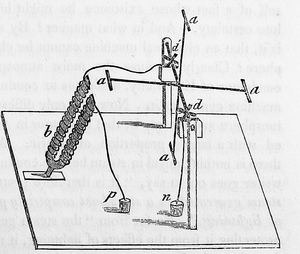 Electromagnetic wheel by Edmundson American Journal of Science, 1834, vol. 26, p. 205 |
| 1834-1835 | In December 1833 the blacksmith Thomas Davenport (American) purchases a solenoid directly from Joseph Henry and begins experiments together with Orange Smalley (American) in a workshop in Forestdale, Vermont.
In July 1834 the two men create their first rotary machine. They improve the device in several steps before they publicly demonstrate it in December 1834 for the first time. In the following year Davenport separates from Smalley. In the summer of 1835 Davenport travels to Washington, D.C., to demonstrate his machine before the patent office and have it registered. Due to lack of money, however, he has to return home without success. |
 First motor of Davenport from his first patent application in June 1835 |
| Aug. 1835 |
Francis Watkins (British) creates an electrical "toy" with which he can bring several magnetic needles to rotation. He describes the apparatus in a paper for the Philosophical Magazine.
He admits to being inspired by the electro-magnetic machine (generator) by Joseph Saxton, which is on display in a public gallery in London since August 1833. Watkins can be counted among the first who understood the principle of reversal of motor and generator. |
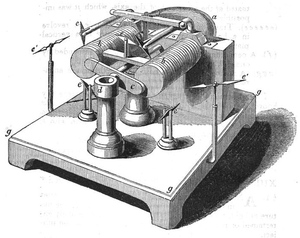 Watkin's toy, 1835 Philosophical Magazine, 1835, vol. 7, p. 112 |
| 1835 | Sibrandus Stratingh and Christopher Becker (Dutch) build a small (30 x 25 cm), electrically driven three-wheeled vehicle of about 3 kg in weight. It can drive roughly 15 to 20 minutes on a table until the battery is empty.
Stratingh and Becker publish a report of their success in the same year. Stratingh knew the work of Jacobi and wanted to build a real electric car in 1840, which he never succeeded. |
 Electric model car by Stratingh and Becker, 1835 |
| May 1836 |
Johann Philipp Wagner (German) presents an electric motor at the Stiftungsfest of the Sencken-bergischen naturforschenden Gesellschaft. His apparatus is similar to the device that Stratingh and Becker created. It can run for about 10 mins until the battery is empty.
Wagner holds his construction a secret and so there are reports on the demonstration, but no drawings of the machine. In subsequent years, Wagner developes his engine further and publicly demonstrates improved versions. |
| 1836 1837 |
Davenport has been further improving his devices. In 1836 he finds a new partner in Ransom Cook and moves to Saratoga Springs, New York to further develop his motors. With the help of Cook he builds a model for the patent office. On January 24, 1837, Davenport files his caveat in Washington and on February 5, 1837, he gets the first U.S. patent for an electric motor: "Improvement in propelling machinery by magnetism and electromagnetism". His model motor is now on display in the Smithsonian Institute in Washington, DC. Davenport's patented design uses four rotating electromagnets that are switched by a commutator, and ring-shaped fixed permanent magnets made of soft iron. An improved motor, which he presents in August 1837, has 6 inches in diameter, rotates at about 1,000 revolutions per minute and can lift a 200 pound weight one foot in one minute. This corresponds to a power of 4.5 W. Davenport continuously improved his designs in the following years.
Together with Edwin Williams of New York and his partner Ransom Cook, Davenport forms a joint capital stock association on March 3, 1837. However, Williams fails to sell enough of the stocks and the whole undertaking collapses just one year later.
|
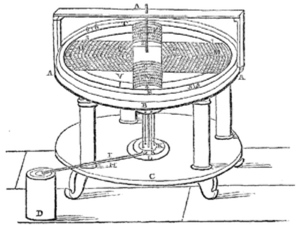 Davenport's patented motor, February 1837 |
Thomas Davenport – Inventor of the electric motor?
There are several texts of dripping pathos in US-American literature that celebrate Thomas Davenport as inventor of the electric motor. This assertion is based on the undisputed fact that Davenport was the first American who created a useable electric motor and also the first to receive a patent for such a device in the beginning of 1837.
Davenport, however, was far from being the first to build an electric motor. In Europe (especially in England, Italy and Prussia) technology was already much advanced. Already in summer 1834, three years before the patent, Moritz Jacobi presented a motor that was three times more powerful than an improved machine, which Davenport had developed in the months after his patent application. In addition, Davenport's motor was running faster than Jacobi's. So the output torque of Davenport's motor, the decisive factor in the comparison of electric machines, was only about one tenth of Jacobi's three years earlier design.
In 1835, shortly after Jacobi's motor, the two Dutchmen Strating and Becker already presented a first practical application by driving a small electric model car.
In the years following Davenport's patent the advancement of Jacobi hardly diminished. At the same time when Jacobi demonstrated his next machine in the fall of 1838, a motor that was capable of 300 W output power and could drive a boat occupied with 14 people across a wide river, Davenport showed a tiny model train.
Davenport's motor is not remarkable in a historical context. His construction is not a substantial improvement of other contemporary designs.
Over the years, Davenport manufactured quite a number of machines. But unlike Werner Siemens, George Westinghouse and Thomas Edison, he was not the founder of an important company. And unlike Nikola Tesla, for example, Thomas Davenport was never able to sell nor license his patent.
Davenport did not receive the patent on the electric motor as such but only on his special design features. In the years from 1837 to 1866 about 100 patents on electric motors were granted to other inventors in England alone. After Davenport redesigned his motor already during 1837 his patent became practically worthless.
Davenport is the honor of being the first of thousands of engineers who received a patent for an electric motor. But he is neither their inventor nor did his designs have had any significant influence on the further development of electric motors.
Timetable 1838 - 1854: Stronger motors, new applications
| Febr. 1838 |
Watkins publishes an extensive article in the Philosophical Magazine where he presents his motor. |
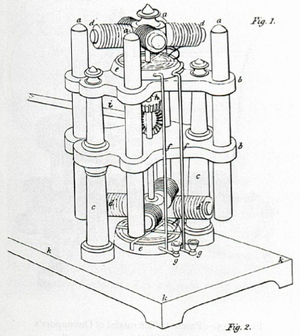 Watkin's motor, February 1838 Philosophical Magazine, 1838, vol. 12, pl. 4 |
| Aug. 1838 | In August, 1838, a tiny model train with one of Davenport's motors is displayed in London. It moves at 3 mph. |
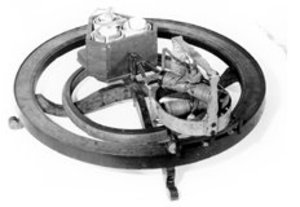 Davenport's model train, 1838 Photo courtesy of the Division of Work & Industry, National Museum of American History, Smithsonian Institution |
| Sept. 1838 |
Jacobi moves to St. Petersburg in August 1838 at request of the Russian Tsar. He was accepted at the St. Petersburg Academy of Sciences and generously supported by the Tsar in his further work on electric motors.
On 13 September 1838, Jacobi demonstrates for the first time on the river Neva an about 8 m long, electrically powered boat with paddle wheels. The zinc batteries have 320 pairs of plates and weighed 200 kg. They are placed along the two side walls of the vessel. The motor produces between 1/5 and 1/4 hp power (300 W), the boat travels with 2,5 km / h over a 7.5 km long route. It can carry more than a dozen passengers. Jacobi drives around for days on the river Neva. Contemporary newspaper articles state that after two to three months of operation the zinc consumption was 24 pounds. |
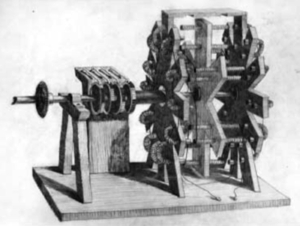 Improved motor of Jacobi, 1838 |
| 1838 | Charles G. Page (American) starts a lifelong occupation with electric motors.
Over the next 20 years, Page is researching to find better, more powerful machines. His engines were sold via catalog in the U.S. and reached a high level of public awareness. In early years, many inventors of electric motors mimic steam engines with an oscillating (reciprocating) piston. Page also builds such a machine (see right), but then turns to rotating devices. |
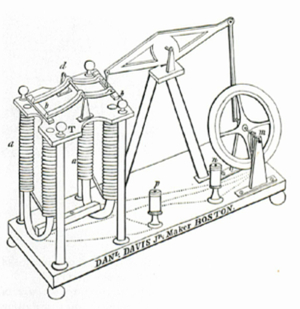 First motor of Page, 1838 American Journal of Science, 1838, vol. 35, p. 264 |
| Aug. 1839 |
On 8 August Jacobi tests an improved electric motor with three-to four-fold the mechanical performance of his second machine of 1838 (about 1 kW). His boat is now reaching 4 km/h. A key factor for his success is the improved zinc-platinum battery according to William Robert Grove, which he has made himself.
In October 1841 Jacobi demonstrates once again a further improved motor, which, however, is only slightly superior to the model from 1839. This is the last electric motor Jacobi ever builds. He now turns to the theory of electric motors and later moves on to other electric phenomena. |
| 1837- 1842 |
Robert Davidson (Scottish) also developed electric motors since 1837. He made several drives for a lathe and model vehicles.
In 1839 Davidson manages the construction of the first electrically powered car. In September 1842, he makes trial runs with a 5-ton, 4.8 m long locomotive on the railway line from Edinburgh to Glasgow. Its engine makes about 1 hp (0.74 kW) and reaches a speed of 4 mph (6.4 km / h). |
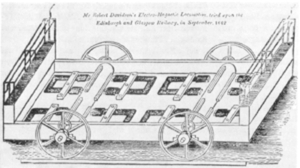 First electric locomotive by Davidson, 1839 From T. du Moncel, Electricity as a Motive Power, London, 1883, fig. 32 |
In subsequent years, a flood of patents on electromagnetic machines begins - about 100 in England alone between 1837 and 1866.
Among the inventors who deal with electric motors are: James Joule (English, ab 1838), William Taylor (English, ab 1838), Uriah Clarke (ab 1840), Thomas Wright (ab 1840), Wheatstone (English, ab 1841), de Harlem (ab 1841), P. Elias (US-American, ab 1842), G. Froment (French, ab 1844), Moses G. Farmer (US-American, ab 1846), G. Q. Colton (US-American, ab 1847), Hjorth (ab 1849), Thomas Hall (US-American, ab 1850), T. C. Avery (ab 1851), Sören Hjorth (Danish, ab 1851), Du Moncel (French, ab 1851), Marié Davy (French, ab 1855), Pacinotti (Italien, ab 1861)
and others.
Initially there is a contest between oscillating (reciprocating) and rotary machines. Later, the oscillating machines disappear completely from view.
A fundamental problem of the early electric motors is that the electric current from the galvanic elements (zinc batteries) is far too expensive to compete with steam engines. R. Hunt reported in 1850 in the British Philosophical Magazine that the electrical power even under the best conditions is 25 times more expensive than a steam engine. Only with the ongoing development of the electric generator (dynamo) the situation is beginning to change.
| 1840 | On 18 January, 1840, the first edition of Davenport's new newspaper, Electro Magnet and Mechanics Intelligencer, is released. The printing press is driven by two of his own motors. The motors do supposedly about 2 hp, which is about 1.5 kW. |
| 1841- 1844 |
On the initiative of Wagner, the German Confederation under the leadership of Prussia, Bavaria and Austria, sets a prize of 100,000 Gulden in 1841 for the construction of an electrical machine whose power is cheaper than that of horses, steam, or human power.
Of course, this price attracts other inventors, who start working on an electric motor in parallel to Wagner's efforts. Among them are Mr Karl Ludwig Althans from Bückeburg close to Minden, Emil Stöhrer from Leipzig, Emil Groos from Karlsruhe and Peter Bauer from Nuremberg. In particular, Stöhrer designs a remarkable machine in 1843. In examining the final Wagnerian machine in May and June 1844 in Frankfurt am Main, the federal Commission determined a power of only 50 watts. The zinc consumption is so high that horse, steam and manpower is considerably cheaper. Because of this failure the price is withheld from Wagner and he falls from grace. Without a powerful electric generator this competition could not be won, and for such a generator mankind had to wait another 25 years. |
| 1851 | Page boosts its motors from 8 to 20 HP power.
With two engines, he drives a 10-ton locomotive with a top speed of 30 km/h. He travels the route from Washington to Bladenburg in 19 minutes. |
| 1854 | Another, 12-ton locomotive of Page is traveling on the route from Baltimore to Ohio. |
